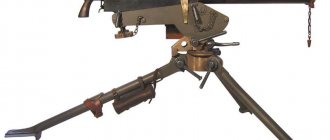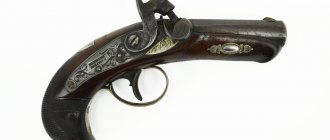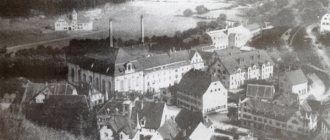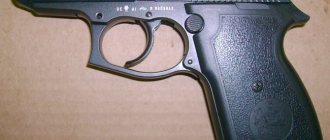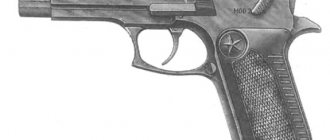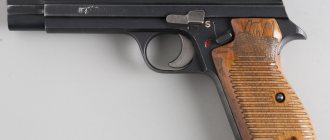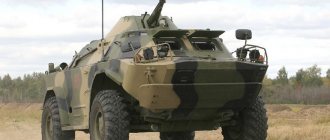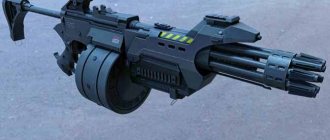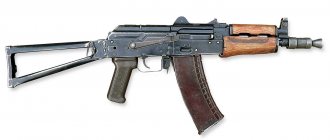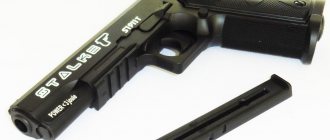26.05.2012
American Browning M1918 light machine gun (BAR)
J. M. Browning's automatic rifle BAR
(
Browning Automatic Rifle
) was created in 1917. While working on the automatic rifle, the designer assessed the experience of the First World War. First of all, this was manifested in the introduction of a fire mode translator and a replaceable magazine. In the United States Army, the BAR became a light machine gun with the maneuverability of a rifle, and its crew consisted of one man.
The rights to manufacture the Browning Automatic Rifle were acquired, but the possibility of its production by others remained (Winchester). Production began in February 1918, but BAR's combat experience in World War I did not go beyond military testing. Despite this, both the French and the British rushed to order BAR. Under the obvious influence of this machine gun, the French created the Chatellerault light machine gun.
The design of the BAR machine gun was based on the Vickers-Berthier system of the 1908 model, which had minor modifications. The barrel in the receiver was fastened with a thread (this fastening did not allow the barrel to be replaced in combat conditions) and was equipped with a smooth muzzle sleeve - “extension”. At first, five and later four left-hand rifling were made in the barrel bore. Their stroke length was 254 millimeters. The automation worked thanks to the removal of powder gases from the barrel bore. The gas chamber is a closed type. The gas regulator, having three holes, was screwed in front of the guide tube. A swivel clamp and a wooden forend with a notch were attached to the guide tube.
The barrel bore was locked by a lever hinged to an eye located in the middle part of the bolt. The bolt was attached to the bolt frame through a hinged earring. There was a protrusion at the top of the milled receiver. A return spring was placed in the guide tube.
While the moving system was moving forward, the shutter reached the stump of the barrel and stopped. The bolt frame, continuing to move, rotated the earring, and the rear part of the locking lever rose. The supporting surface of the lever was wound behind the supporting surface of the receiver protrusion. After the shot, the bolt frame moved back, lowered the lever and unlocked the barrel.
An insert placed under the earring axis prevented premature unlocking. He did not allow the locking lever and the earring to lower until the bolt carrier reached the appropriate position. The cartridge case was removed by the bolt ejector and the rigid reflector of the trigger box. The bolt frame hit the buffer at the rearmost point. When firing, the charging handle remained motionless.
The trigger mechanism (trigger mechanism) allowed for both single and continuous fire. After the barrel bore was locked, the insert struck the firing pin mounted in the bolt. Before locking, the locking lever did not allow the striker to advance, and when unlocked, it was retracted. That is, the combination of the locking lever and the protrusion of the striker acted as an automatic safety device. The trigger, equipped with a buffer spring, was mounted on a frame, which was located inside the trigger box. When the trigger was pressed, the disconnector connected to it raised the front end of the trigger lever, releasing the bolt frame from cocking.
The translator-safety flag was located behind the trigger guard on the left. In the forward position (“F”), the disconnector rose and jumped off the trigger lever. He, in turn, returned to its original position, intercepting the bolt frame. If the flag was in a vertical position (“A”), the translator’s pin limited the rotation of the trigger lever in such a way that there was no disconnection, and the automation cycle was repeated. If the flag was turned back (“S”) the trigger was blocked by a pin.
A folding frame sight was installed on the receiver. The butt, which had a semi-pistol protrusion, was put on the tail tube of the receiver and secured with a screw, reinforced with a metal back. The sling swivel was attached to it from below.
Food was supplied from a two-row box magazine. The arrangement of cartridges is staggered. The magazine latch was controlled using a button located inside the trigger guard. Thus, to speed up reloading, the shooter could press the latch using the finger of the shooting hand. The machine gunner carried spare magazines on his belt in canvas pouches. The BAR design consisted of 125 parts, 11 of which were springs.
“Winchester” and “Colt” provided the weapon with a good finish, and its mass made it possible to fire bursts with acceptable accuracy, but only from point-blank range. The combat rate of fire in short bursts was 60 rounds per minute, in long bursts - up to 180 rounds per minute, provided that the magazines were changed quickly.
In 1922, the United States Cavalry adopted its own modification of the BAR Model 1922 as a light machine gun that was carried without a pack. The barrel was weighted to 1575 grams and equipped with transverse ribbing up to the middle of its length. The frame sight, which has a mechanism for introducing lateral corrections, was borrowed from the Browning M1919 heavy machine gun. A bipod (weight 1.42 kg) was attached to the guide tube in front of the forend; the legs were fixed in the combat position with spacers. In the recess of the butt there was an additional folding support. The sling swivels were “thrown” to the left side, similar to a cavalry carbine. The BAR Model 1922 was produced in small quantities.
US Marines prepare to land on Tarawa Atoll. Behind are the M1 Garand and M1918 Browning rifles.
US police used a self-loading version of the BAR "Monitor".
In 1937, the army received the M1918A1 light machine gun, which was slightly different from the M1918. We installed a sight similar to the Enfield M1917 rifle. A folding bipod was attached in front of the forend, and a folding shoulder support was attached to the back of the butt. The M1918A1 did not reach the level of the Model 1922, but it was the Model 1922 that was completely withdrawn from service in 1940.
In 1941, just before the United States entered World War II, the significantly modernized BAR M1918A2 was adopted. Instead of continuous and single fire modes, continuous fire modes were introduced at different rates - 300-450 rounds per minute (flag “F” positions) and 500-550 rounds per minute (flag “A” positions). To simplify the operation of the gas regulator head, it has been modified. The sight is a Browning M1919 type. A metal plate was mounted into the shortened forend, which protected the recoil spring and the forend from overheating.
The barrel was equipped with a slotted flame arrester. The magazine guides were screwed to the trigger box, which reduced the risk of losing it. The shoulder support has been shortened. There was an additional support in the butt, but users almost immediately began to remove it (something similar happened with the DP butt support). The bipod was moved to the muzzle of the barrel and equipped with wide shoes. Thumbscrews were used for fixation. This position of the bipod limited the aiming sector and many machine gunners removed them, so over time the bipod was placed on the guide tube of the M1918A2 machine gun. In battle, machine gunners did not use the shoulder support either, so it was dismantled to make the weapon lighter.
A German soldier (possibly an officer) surrenders to an American soldier armed with a BAR M1918A2 automatic rifle
By the beginning of the war, the BAR was a squad and platoon weapon. The Americans continued organizational experiments during World War II, but each time the BAR again became the core of small fire groups. However, with a relatively light, non-replaceable barrel and limited magazine capacity, the machine gun could not provide long-term fire support. Even when firing in short bursts, the overheated barrel produced visible flames and smoke. It can be assumed that the lack of a light machine gun that satisfied all the requirements forced the Americans to introduce into the infantry squads soldiers armed with combat shotguns, which made it possible to conduct close combat in the thickets.
In addition to Marlin-Rockwell, Winchester Repairing Arms and Colts Patent Firearms, BAR was produced by New England Small Arms and IBM. The markings applied to the receiver included the inscription BROWNING BAR М1918 CAL 30 MFD BY (manufacturer's name).
Early production BARs were returned to factories during the war to be brought up to the level of the M1918A2. Since 1942, machine guns were equipped with a plastic butt, which was reinforced with a metal bottom plate and back of the head. In addition, there was a carrying handle. BARs were supplied to the UK for local defense forces between 1940 and 1941. American Marines preferred the M1918A2, which was modified in military workshops to give them a single-fire mode. In general, due to the large number of alterations and “local upgrades”, many variations of the BAR appeared.
The number of different models produced by BAR is estimated at 1 million pieces, of which more than 350 thousand Model 1922, M1918A1 and M1918A2 machine guns were produced in the United States in 1922-1945 and during the Korean War. After the single 7.62 mm NATO cartridge (7.62×51) was adopted, the T34 machine gun was specially made for it, but this BAR version remained only experimental. Although the BAR М1918А2 was officially withdrawn from service in 1957, it continued to serve later. The machine gun finally left the world stage only in the 80s.
To unload the BAR you must: disconnect the magazine by pressing the magazine release button located in front of the trigger guard. Pull the charging handle back. Inspect the chamber through the receiver window. Return the charging handle to the forward position and pull the trigger.
American soldier with various US Army weapons.
In the picture (counterclockwise):
1. Self-propelled howitzer NMS M7. Considering the prefabricated bow piece (not one piece) and the lack of folding sides of the wheelhouse, this cannot be a later model M7B1. The familiar name "Priest" is not suitable, since it was used in the UK, not in the USA. On the turret is a 12.7 mm (50 caliber) Browning M2HB machine gun.
2. 37 mm M3 anti-tank gun.
3. Easel 7.62 mm (30 caliber) Browning M1919A4 machine gun.
4. Thompson M1928A1 submachine gun.
5. Browning M1918A2 Automatic Rifle (BAR).
6. "Browning" M1917A1. Like the M1919, a 7.62 mm heavy machine gun.
7. 60 mm M2 mortar.
8. 81 mm M1 mortar.
In the inner circle are an M1 self-loading carbine, a Springfield M1903 rifle and a Colt M1911 A1 pistol; in the soldier’s hands is a Garand M1 self-loading rifle.
Procedure for partial disassembly of BAR M1918A2:
1. Unload the machine gun.
2. Turn the contactor flag down, remove the contactor, separate the trigger box and pistol grip.
3. Pull the charging handle back a little until the axis of the earring and the hole on the receiver are aligned. Pull out the axle and separate the charging handle.
4. Remove the bolt carrier liner.
5. Remove the return spring rod.
6. Lower the tube lock flag. Remove the checkbox. Separate the tube with the bipod.
7. Pull the bolt frame forward.
8. Move the shutter latch to the left. Remove the bolt from the receiver.
Assembly was carried out in reverse order.
Performance characteristics
The Browning-M1919 machine gun served until 1970, but gradually began to remove this model from service by the end of 1945 due to an analysis of combat operations in general, which showed that the machine gun was obsolete, and emerging models (including in other countries ) push the product, according to its characteristics, to the second (or even third) plan.
The Browning light machine gun weighed 14 kg, length 1219 millimeters, of which the barrel was 609 mm. Rate of fire from 400 to 600 rounds per minute based on the principle of recoil of the barrel at a short stroke with lever locking.
Power was supplied by a machine gun belt with 250 rounds of ammunition at a maximum sighting range of 1,369 meters.
ARS Kerylos
It seems that there is no person who has not read the brilliant novel “The Three Musketeers” by Alexandre Dumas at least once in his life. Unlike numerous film adaptations, the novel describes a curious intrigue - the musketeers' search for funds to purchase equipment for military operations.
The methods of medieval vassalage—the overlords shifting the financial burden onto the shoulders of vassals, nobles, and subsequently ordinary military personnel—developed creatively in the Russian Empire. Of course, the War Ministry did not refuse to arm its personnel. However, the difference between service weapons and the urgent needs for military models, in the literal sense, turned out to be fateful.
Personal weapons of Russian officers in the 19th century
On the eve of the Crimean War, a Russian officer was entitled to two single-shot capsule muzzle-loading pistols. The chief army quartermasters assured that the capsule pistol was quite sufficient for the combat effectiveness of the army. It could be fired once, and then, taken by the barrel, used in hand-to-hand combat, stunning the enemy left and right. If an officer wanted to get a rapid-fire weapon, he purchased a revolver at his own expense, based on the list of weapons recommended for purchase.
“The introduction of fast-loading weapons” was recorded in the Charter of the combat infantry service only in 1860, at the suggestion of Baron Zeddeler (who later became an infantry general). Since the time of Peter I, the Russian Empire has been constantly at war. Yes, and the pre-Petrine archers did not stay at home. To ensure that their lives and military careers were not prematurely interrupted, officers had to purchase reliable weapons at their own expense. This is exactly the case when the greedy person pays twice if he manages to live to see the second time.
Shooting school in Oranienbaum: tests of a Nagan system revolver
A similar situation arose at the beginning of the 20th century, when a discussion arose in the Russian military environment: whether to consider a revolver as an effective weapon or, following the example of European countries, switch to self-loading pistols. After tests carried out at the officer rifle school in Oranienbaum, the military leadership ordered that the revolver be considered a reliable weapon, which, by the way, was true.
And those wishing to become the happy owners of modern self-loading pistols were given another Highest command. By order of the military department No. 74 of 02/07/1907, the Browning pistol No. 2 model 1903 was added to the list of models recommended for purchase.
Browning in service with a separate gendarme corps
Suddenly, to everyone’s surprise, the military learned that while discussions and tests were going on in the army, the Browning pistol had already been used as a service weapon for a couple of years by employees of the Russian Ministry of Internal Affairs and by members of a separate gendarme corps.
The Browning era begins in 1896, when the commercial director of the armories built near the city of Liege, Hart O'Berg, invited the talented American designer John Browning and his brother Matthew to Belgium. Just four years later, the newest Browning No. 1 pistol, model 1900, appeared. This was a revolution in the design of handguns. Before Browning, such famous gunsmiths as Mauser, Bergman, Luger, Borchardt, designed a pistol according to the so-called “rifle design”. The barrel, then a permanent magazine, filled with cartridges from clips or packs. The bolt and trigger mechanism (trigger) were placed in the receiver. The weapon was heavy, had large dimensions and a considerable number of protruding parts.
Browning took a different path - he hid the barrel and trigger under an external fixed bolt casing. The return spring was placed above the barrel in a special groove. The spring was connected by means of a rod to the earring, suspended from the inside to the top bar of the casing shutter. The lower end of the rotating earring was connected to the striker, and the return spring was also activated to activate the striker. The power imparted to the striker made it possible to ignite even third-rate capsules. In 1900, the Browning pistol was adopted by the Belgian army, and after a short time the pistol appeared on the public market.
Despite the fact that Browning No. 1 was immediately adopted by the Belgian army, the European military reacted to it with coolness. Even taking into account the exceptional properties, one significant drawback remained - the low power of the 7.65 caliber cartridge. During 1900-1910, 724,450 pistols were produced.
At the same time, the pistol was liked by revolutionaries, including Russian Socialist Revolutionaries. In 1906, twelve Latvian Social Democrats, armed with Browning guns, robbed a state bank in Helsingfors (Grand Duchy of Finland of the Russian Empire). Browning was also used to shoot at Stolypin in 1911, and at Lenin in 1918.
Browning No. 2 Model 1903
Having gained the necessary experience in fine-tuning the first model, Browning, at the request of the military, quickly released the next model - Browning No. 2 of the 1903 model. For this model, the designer specially developed a 9 mm cartridge, called the “Browning Long”. The design of the pistol has been simplified, and disassembly has become extremely simple. The length of the pistol was 203 mm, weight 910 g, barrel length 128 mm. The clip held 7 rounds, although an extended clip with 10 rounds was also produced. A small batch of Brownings was equipped with wooden holsters - butts. The pistol was adopted in Belgium, Serbia, Turkey, Russia, the Netherlands, Paraguay and Peru.
In Sweden, Browning was produced under the name “Model No. 7” at the state arms factory in the city of Huksvarna. The first batches of the Swedish Browning model were purchased for a separate corps of gendarmes in Russia. Employees of the Tsar's Secret Service quickly appreciated the qualities of this pistol. Thanks to the absence of protruding parts, as well as smooth contours, the pistol was easily hidden under clothing. The trigger hidden in the body made it possible to fire the first shot even through clothing. However, one shot was enough for the professionals. Meanwhile, some experts believed that the pistol had excessive power, as for a service weapon. The gendarmes, who survived brutal firefights with Russian revolutionary terrorists, did not agree with this definition.
Browning pistol in the Russian army
The pistol also took root in the Russian army. It became the favorite weapon of pilots of the Imperial Air Force and officers of armored divisions. In the cramped cabins of aircraft and armored cars, where there was no extra space, the Browning could easily be hidden in the inner pocket of a jacket or in the back pocket of a riding breeches.
Only for a separate corps of gendarmes 10 thousand pistols were purchased. The army purchased for itself separately. For comparison, on the eve of the First World War, up to a thousand Luger pistols were purchased for the Russian army.
Browning - Arkady Gaidar's personal weapon
During the Civil War, Brownings were used on both front lines. According to one legend, Browning No. 2 model 1903 was loved by the leader of the October Revolution, Vladimir Lenin. The future children's writer, and during the civil war - the young regiment commander of the Red Army Arkady Gaidar, also had a soft spot for this model of pistol.
After the revolution, party workers, as well as operational officers of the criminal investigation department and the OGPU, armed themselves with Browning. The thoughtfulness of the design and quality of manufacture of Brownings of the 1903 model allowed the pistols to be used in the USSR until the 40s.
In 1910, the next model appeared - the civilian model N2. The updated pistol uses a hammerless mechanism (strike-fired). The lightweight, 600 grams, 152 mm long, 7.65 caliber seven-shot pistol has been a commercial success all over the world.
When in the early 20s of the twentieth century the government of Yugoslavia ordered 60,000 pistols for the army, based on the 1910 model, they developed a new army pistol for the caliber 7.65 mm and 9 mm “short”. The length increased to 178 mm, the weight was 730 g, and the magazine capacity was 9 rounds. This pistol was in service in Yugoslavia, Belgium and the Netherlands. In the Wehrmacht it was coded "P626(b)". Production of the 1922 Browning continued until 1961. A total of 396,865 pistols were produced.
With the creation of a pistol of the 1903 model, John Browning predetermined the path of development in the design of pistols for decades. Browning's ideas were used to develop such legendary pistols as the Colt 1911 and TT, as well as the Walter PPK, PM, and Stechkin pistol. By the way, during the Second World War, German saboteurs used Brownings of the 1903 model because of their similarity to the TT. In 1986, the Swedish army removed the Lahti pistol from service and rearmed again with a modified “Model N7”, in other words, a Browning Model 1903.
John Moses Browning went down in history as the unsurpassed genius of automatic weapons. In addition to pistols, the gunsmith's interests ranged from hunting rifles to heavy machine guns. Some of Browning's "brainchildren" from a century ago are still in demand. Hunters continue to use the Auto-5 self-loading shotgun, and the M2 machine gun remains in service with the US Army and NATO countries. Browning pistols became so popular in the 20th century that “Browning” became a household name. Every automatic pistol, regardless of brand, was called Browning.
Operation and combat use
M1919A6. Battle on the Chongchon River. Korea, November 1950
- Great Britain: supplied under Lend-Lease;
- Vietnam: captured machine guns were used by the North Vietnamese army and South Vietnamese guerrillas during the Vietnam War;
- Dominican Republic: supplied under the US military assistance program;
- Republic of China: supplied under the US military aid program during the Chinese Civil War from 1946 to 1949 and thereafter;
- Nicaragua: supplied under the US military assistance program;
- Panama: supplied under the US military aid program;
- El Salvador: supplied under the US military aid program;
- USSR: supplied under Lend-Lease;
- USA;
- Republic of Korea: for military assistance programs;
- South Vietnam: through military assistance programs;
- Japan: captured machine guns were used by the Japanese army during World War II; after the surrender of Japan, machine guns were supplied under the military assistance program from the United States for the self-defense forces, which were armed with the M1919A4 and M1919A6 until the early 1980s;
Options
- M1919
- M1919A1
- M1919A2
- M1919A3
- M1919A4
- M1919A4E1
- M1919A5
- M1919A6
All these options differed in numerous small details and specific release technology; Over the many years that the machine gun remained in production, small differences only accumulated. But in general, the design of the M1919 remained unchanged. The machine, as a rule, was in the form of a tripod, and there were a large number of different types of tripods - from those used in infantry to large and complex ones intended for firing at aerial targets. There was also a great variety of different types of machines for installing a machine gun on all types of cars (from jeeps to fuel tankers), as well as on boats and boats
.
The classification of modifications varies depending on the desired objectives or performance analysis. This machine gun is often referred to as the Light Machine Gun, while the M1917 and M2HB are referred to as the Heavy Machine Gun. But there is also such a definition as “M1919A6 Medium Machine Gun”. The weight and layout of the structure, the lightest modification, in terms of mobility, firing and maintenance (a plywood or metal box with a canvas or metal tape was placed next to the machine gun), can hardly be called “Light”. Compared to another descendant of the Maxim, the MG 08/18 (with an attached container and belt, had the ability to fire on the move), the lightening of the M1919 did not provide the advantages sought when creating a “light machine gun,” especially from 1943 to 1954 when the M1919A6 was on the production line. The calculations preferred the low-profile M2 machine rather than the metal shoulder rest and bipod. Such a technical rollback from the M1919A6 to the M1919A4 was externally indicated by: a flash suppressor, a lightweight barrel, a carrying handle, a remote bolt stop, and a receiver cover latch.
.
